

Nova: Building Pharaoh's Chariot (Full Documentary) Chariot. Ancient Roman Chariot Races. EtruscansAncient Rome Medieval Rome RenaissanceBaroqueModern Rome.
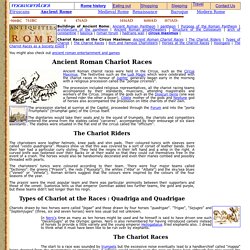
Your First Resource. Approximate historical map of the spread of the spoke-wheeled chariot, 2000–500 BC A chariot is a type of carriage driven by a charioteer using primarily horses[a] to provide rapid motive power.
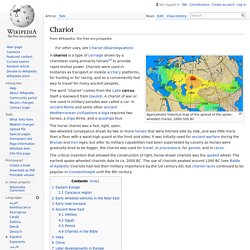
Chariots were used in militaries as transport or mobile archery platforms, for hunting or for racing, and as a conveniently fast way to travel for many ancient peoples. The horse chariot was a fast, light, open, two-wheeled conveyance drawn by two or more horses that were hitched side by side, and was little more than a floor with a waist-high guard at the front and sides. It was initially used for ancient warfare during the Bronze and Iron Ages, but after its military capabilities had been superseded by cavalry as horses were gradually bred to be bigger, the chariot was used for travel, in processions, for games, and in races. Chariot. Charioteer facts. Ten fun facts you probably didn't know(from Roman Mystery XII, The Charioteer of Delphi) diagram of the Circus Maximus in the 1st century AD (from The Charioteer of Delphi)1.
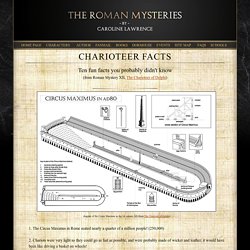
The Circus Maximus in Rome seated nearly a quarter of a million people! (250,000)2. Chariots were very light so they could go as fast as possible, and were probably made of wicker and leather; it would have been like driving a basket on wheels! 3. Journal of Roman Archaeology - The genesis and performance characteristics of Roman chariots. Superweapon of the Ancient World: A History of Chariots - Part I. The chariot is often associated with the ancient Egyptian civilization.
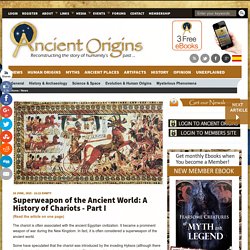
It became a prominent weapon of war during the New Kingdom. In fact, it is often considered a superweapon of the ancient world. Some have speculated that the chariot was introduced by the invading Hyksos (although there is no factual evidence to support this claim). The history of the chariot, however, stretches back more than a millennium prior to its introduction into ancient Egypt. Additionally, one has to travel to the west of Egypt’s borders to discover its ancient origins. In 1927/8, the British archaeologist, Sir Leonard Woolley was excavating the Royal Cemetery of Ur in modern day Iraq, when he discovered an artifact known today as the Royal Standard of Ur (dated to the third millennium BC). E Lawrence with Leonard Woolley, the archaeological director, with a Hittite slab on the excavation site at Carchemish near Aleppo before the First World War.
Standard of Ur, 26th century BC. The chariot in Ancient Egypt. History Chariots seem to have originated in Mesopotamia in the third millennium BCE.
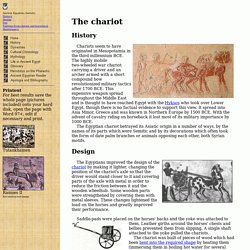
The highly mobile two-wheeled war chariot carrying a driver and an archer armed with a short compound bow revolutionized military tactics after 1700 BCE. This expensive weapon spread throughout the Middle East and is thought to have reached Egypt with the Hyksos who took over Lower Egypt, though there is no factual evidence to support this view. It spread into Asia Minor, Greece and was known in Northern Europe by 1500 BCE. With the advent of cavalry riding on horseback it lost most of its military importance by 1000 BCE.
Design. Chinese Chariot Parts Diagram. The ancient Chinese chariot (Chinese: t 戰車, s 战车, p zhànchē, lit.
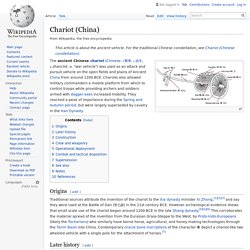
"war vehicle") was used as an attack and pursuit vehicle on the open fields and plains of Ancient China from around 1200 BCE. Chariots also allowed military commanders a mobile platform from which to control troops while providing archers and soldiers armed with dagger-axes increased mobility. They reached a peak of importance during the Spring and Autumn period, but were largely superseded by cavalry in the Han Dynasty. In ancient China the chariot was used from the time of the Shang Dynasty until the early years of the Han Dynasty (c. 1200–200 BCE) when it was replaced by cavalry and fell back into a secondary support role. For a millennium or more, every chariot borne soldier had used the particular combat tactics that use of the vehicle required. Chariot based combat usually took place in wide-open spaces. During the Western Zhou Era, chariots were deployed on wide open plains abreast of each other in a single line.
Roman Chariot Parts Diagram. Infographic design. Chariot. The chariot was a light vehicle, usually on two wheels, drawn by one or more horses, often carrying two standing persons, a driver and a fighter using bow-and-arrow or javelins.
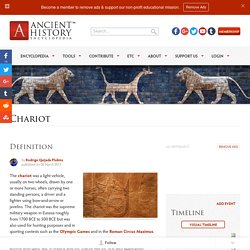
The chariot was the supreme military weapon in Eurasia roughly from 1700 BCE to 500 BCE but was also used for hunting purposes and in sporting contests such as the Olympic Games and in the Roman Circus Maximus. Horses were not used for transport, ploughing, warfare or any other practical human activity until quite late in history, and the chariot was the first such application. Donkeys and other animals were preferred in early civilizations. The Horse The horse's main ecological niche was the Eurasian steppe; a very wide (4,800 km) and narrow (800 km on average) strip of grassland running roughly from Hungary to China, encompasing parts of what today is Ukrania, southern Russia, Kazakhstan, Uzbekistan, Turkmenistan, Kyrgyztan, Tajikistan and Mongolia.
Ancient History: Rome If You Want To, Circus Maximus (EP2) - Drive Thru History. Circus Maximus Short Animation. Circus Maximus.